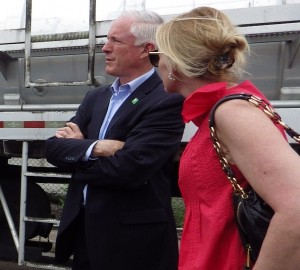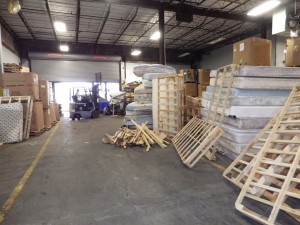Participants in Bridgeport”™s rejuvenation shared their progress and initiatives toward transforming the city on a recent tour of its developing Eco-Technology Park. Investors, developers and government officials came for a daylong visit to learn about Bridgeport”™s overtly green spin on development.
The city, with a historic legacy of blighted industrial buildings and contaminated land, has courted companies involved in environmentally friendly projects that reduce the carbon footprint and bring jobs. The city now has a waiting list for development, according to Mayor Bill Finch, who led the tour.
“We”™re looking at how to repurpose facilities and turn them into green businesses,” said Jeff Leichtman, managing director of New Haven-based Global Infrastructure Strategies.

- Bridgeport Mayor Bill Finch and Sarah Beatty of Green Depot, a Brooklyn-based company that has taken space in Eco-Technology Park. Photo by Danielle Brody
The city is beginning to rely on fuel cell energy with one active plant and two developing.
“Nowhere else in the world will you see three power plants woven into the community,” Finch said.
The 15-megawatt fuel cell facility on Railroad Avenue fuels nearly 15,000 homes and, by accounts and as the tour demonstrated, is considered quiet. The plant, owned by national energy company Dominon Resources Inc. and developed by FuelCell Energy of Danbury, became active last year. It is the largest taxpayer per square foot in the city at 1.5 acres. “I want to hug this thing,” Finch said on the tour.
The city will have two other plants operating, a 1.4-megawatt fuel cell park at the University of Bridgeport and a 5-megawatt renewable energy park on a former landfill at Seaside Park, which could attract companies, Finch said.
“Instead of seeing broken buildings, people will see 9,000 solar panels and fuel cells,” Frank Wolak of FuelCell Energy said of Seaside Park. “It”™s a complete transformation to a more modern city and it crates local jobs.”
About 20,000 of Bridgeport”™s nearly 60,000 houses will be fueled by fuel cells with almost no pollution, Leichtman said.
Behind the Railroad Avenue power plant is a cluster of old factories that Corvus Capital Partners will renovate into a mixed-use “natural gated community between the railroad and the highway,” said Gary Flocco, managing partner of the development company. The group will build more than 300 apartments, a charter school, green space, a grocery store and parking. Flocco said part of the construction should be complete in 30 months.
Finch said the sight will be a positive endorsement of the city for the thousands of train and highway commuters.
Tri-State Flexi-Pave, a New York-based alternative pavement company, recently opened its New England distribution and installation headquarters in the Eco-Park. The pavement is built from discarded tires and is permeable, allowing water to flow through, solving the challenge of tire waste and storm-water runoff, Henri Hillmann, the operations/sales director, said.
Sarah Beatty, founder and president of New York City-based Green Depot, a supplier of vetted, environmentally friendly building and lifestyle products, said her company will occupy part of an 85,000-square-foot space in the technology park.
Park City Green, a recycling facility, is now breaking down notoriously difficult-to-recycle mattresses. A law passed in 2013 required manufacturers to pay for recycling of mattresses sold in the state and implementation started last month. Adrienne Houel, president and CEO of Greater Bridgeport Enterprises, said the facility employs hard-to-hire workers from correctional facilities. Every part of the mattress, from steel springs to the foam, is sent out to be reused. The facility has also been selling and recycling books; none end up in a landfill, she said.
The Bridgeport Biodiesel plant converts used yellow and brown grease from restaurants, universities, hospitals and food stores into biodiesel, which reduces carbon use by 78 percent, Brent Banker, CEO of Tri-State Biodiesel, said.
He said the company chose to come to Bridgeport when he saw what was happening in the city. He said the company is exploring growing algae and converting it into biofuel. “It”™s the holy grail of industrial ecology,” he said.
Scott Guilmartin, of NuPower LLC, said the company plans to create a heating and cooling piping system that captures waste heat from city facilities and deploys it to the Eco-Technology Park and downtown. “Every customer”™s carbon footprint will be reduced,” he said.
Other projects in the works are two anaerobic digesters ”” one for food waste, which is currently burned, and one in the sewage treatment facility that will convert sludge to methane gas and electricity ”” expanded natural gas fueling operations and a hospital waste-processing facility.
A flashy gateway backlit by LED lights powered by solar panels will one day welcome people to the park, Leichtman said. “This is a dramatic look of what Bridgeport could be from the highway,” he said.




















